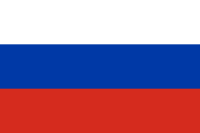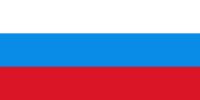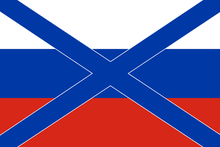Flag of russia
| Flag of the Russian Federation | |
|---|---|
 |
|
| Vexillological symbol : |
|
| Aspect ratio: | 2: 3 |
| Officially accepted: | December 11, 1993 (originally January 20, 1705) |
The flag of Russia is a tricolor made up of three horizontal stripes of equal size in the colors white - blue - red and is based on the flag of the Netherlands . In 1848 the flag colors were declared Pan-Slavic colors .
Officially, the flag was first used on Russian merchant and warships in 1896 . Unofficially, the flag was used after the fall of the tsar during the Provisional Government of Russia and until the October Revolution . By 1991 it was superseded by the flag of the Soviet Union .
history
When Tsar Peter I , known as the Great, traveled to the Netherlands in 1699 to learn more about shipbuilding , he realized the need for Russia to have its own flag for its navy .
The new Russian flag followed the model of the flag of the Netherlands , but Peter the Great propagated a Russian model for the colors of the flag. The colors are said to come from the coat of arms of the Principality of Moscow : on a red background, a white knight rides a white horse, wrapped in a blue coat and wearing a blue shield.
Later, the three colors were also interpreted as a symbol for the three East Slavic peoples in the Russian tsarist empire: white for the " Belarusians ", blue for the " Little Russians " and red for the " Great Russians ". Other sources interpreted the white color as a symbol of freedom, the blue as a reference to the Blessed Mother and the red as a symbol of the power of the tsars.
This flag was declared the official national flag of Russia on May 7, 1883 . When the Bolsheviks seized power in 1917, they changed the national flag.
In the Russian Civil War (1918–1922) after the October Revolution, the flag was used by the anti-Bolshevik White Movement and White Army .
During the Second World War , the white-blue-red tricolor was used by the anti-Soviet troops collaborating with Nazi Germany. Members of the Russian National People's Army wore cockades in the colors white-blue-red. The Russian Liberation Army (ROA), led by Andrei Vlasov, used the tricolor flag as an army flag when ROA soldiers appeared. When searching for drafts for the ROA badge, sketches with the colors white, blue and red were also submitted. However, these were crossed out personally by the Reich Minister for the Occupied Eastern Territories, Alfred Rosenberg .
On August 22, 1991 the white-blue-red tricolor was again designated as the Russian national flag.
Peter I also gave the country another flag: the so-called "Imperial Flag of Russia". It consists of a blue St. Andrew's cross on a white background. This flag was used as an alternative to the tricolor, it even dominated the battlefields and in the merchant and navy. The flag is still the official flag of the Russian Navy today .
Today the symbolism of colors is interpreted differently:
- white (Russian: белый) stands for faith and nobility.
- blue (Russian: синий) stands for hope and honesty.
- red (Russian: красный) stands for love, courage and bravery.
Historical flags
| flag | SV | date | function | description |
|---|---|---|---|---|
 |
2: 3 | 1668 and 1690s | According to some Russian historians, supposedly the first Russian flag from 1668, but possibly just an informal naval variant of the flag from 1699 | Blue cross, alternating in the corners, clockwise red and white |
 |
2: 3 | 1699-1858 | Flag of Tsarist Russia and the Russian Empire | Horizontal tricolor in the Pan-Slavic colors white, blue and red |
 |
2: 3 | 1858-1883 | Flags of the Romanov and the Russian Empire | Horizontal tricolor in black, gold and white. |
 |
2: 3 | 1883-1917 | Flag of the Russian Empire | Horizontal tricolor in the Pan-Slavic colors white, blue and red |
 |
2: 3 | 1914-1917 | Flag of the Russian Empire | Russian tricolor with the Russian coat of arms in the left upper corner for public use. |
 |
2: 3 | 1917-1918 | Flag of the Russian Republic | Horizontal tricolor in the Pan-Slavic colors white, blue and red. |
 |
1: 2 | 1918-1937 | Flag of the Russian SFSR | Red flag with the old stylized Cyrillic letters РСФСР (RSFSR) at the end of the pole. |
 |
1: 2 | 1937-1954 | Flag of the Russian SFSR | Red flag with the Cyrillic letters РСФСР (RSFSR) in changed writing at the end of the pole. |
 |
1: 2 | 1954-1991 | Flag of the Russian SFSR | Similar to the flag of the Soviet Union , with a vertical blue stripe at the end of the pole. |
 |
1: 2 | 1991-1993 | National flag of the Russian Federation | Horizontal tricolor in the Pan-Slavic colors white, blue and red. |
 |
2: 3 | Since 1993 | National flag of the Russian Federation | Horizontal tricolor in the Pan-Slavic colors white, blue and red. |
Colours
| system | White | blue | red |
|---|---|---|---|
| RGB | 255-255-255 | 0-57-166 | 213-43-30 |
| HTML | #FFFFFF | # 0039A6 | # D52B1E |
Victory flag
The victory flag is a variant of the flag that was hoisted over the Reichstag building on May 1, 1945 and symbolized the end of World War II in Europe . The difference to the flag of the Soviet Union is that the star is slightly larger and the hammer and sickle are missing.
On April 15, 1996, Russian President Boris Yeltsin signed a decree that the flag of victory is equivalent to the Russian flag.
Under President Vladimir Putin , the flag of victory became the official flag of the Russian Army .
Service flags

Standard of the President
| flag | SV | date | function | description |
|---|---|---|---|---|
 |
1: 1 | Standard of the President of Russia | Square version of the national flag with the Russian coat of arms in the center |
Military flags
| flag | SV | date | function | description |
|---|---|---|---|---|
 |
2: 3 | Ministry of Defense of the Russian Federation | ||
 |
2: 3 | Space troops | ||
 |
2: 3 | Strategic missile forces | ||
 |
2: 3 | air force | ||
 |
2: 3 | Airborne troops | 2 planes and a parachute in the center on a blue background with a green band in the lower quarter | |
 |
2: 3 | army | ||
 |
2: 3 | 1712–1917, since 1991 | Naval war flag ; Flag of the Russian Navy | Blue St. Andrew's Cross on a white background |
 |
2: 3 | Jack of the Russian Navy | White St. George's cross on a red background, overlaid with a blue St. Andrew's cross bordered in white | |
 |
1: 2 | Russia's Victory Banner, Red Army Victory Flag | Yellow star in the left upper corner on a red background, a variant of the flag of the Soviet Union . | |
 |
1: 2 | Historical battle flag | Victory flag that was hoisted on the Reichstag building in 1945 . |
Border Guard
| flag | SV | date | function | description |
|---|---|---|---|---|
 |
2: 3 | Border troops of Russia | Blue St. Andrew's Cross on a green background. The cross has a white border. |
See also
- Flags of the Russian Federation subjects
- Flag of the Soviet Union
- Coat of arms of Russia
- Saint George's ribbon
Web links
- Flags of the World - Russia (English)
Individual evidence
-
↑ a b Isabelle de Keghel: The State Symbolism of the New Russia: Traditions, Integration Strategies, Identity Discourses. Lit Verlag , Münster 2008, ISBN 978-3-8258-8862-6 , p. 52 .
Isabelle de Keghel: The state symbolism of the new Russia in transition: From anti-Soviet impetus to Russian-Soviet mixed identity . Research Center for Eastern Europe at the University of Bremen, No. 53, December 2003, pp. 29–34. - ↑ a b Fred S. Oldenburg: From totalitarian rule to controlled democracy . In Heiner Timmermann (ed.): Coming to terms with the past in Europe in the 20th century (Volume 1). Lit Verlag, Berlin 2010, ISBN 978-3-643-10862-3 , p. 224 .
- ↑ a b Sven Steenberg: Vlassow: Traitor or Patriot? Verlag Wissenschaft und Politik, Cologne 1968, p. 91: “The Russian draftsman Rodzewitsch was commissioned to design this badge. He had initially made nine designs in the old Russian colors of white, blue, and red, which were submitted to the Reich Ministry for the occupied eastern territories. They were all returned, crossed out personally by Rosenberg with blue pencil. Vlasov said bitterly: "I would like to leave it that way: the Russian flag, crossed out by the Germans because they are afraid of it."
- ↑ Sven Steenberg: Vlassow: Traitor or Patriot? Verlag Wissenschaft und Politik, 1968. p. 64.
- ↑ John Due Enstad: Soviet Russians under Nazi Occupation: Fragile Loyalties in World War II . Cambridge University Press , Cambridge 2018, ISBN 978-1-108-42126-3 , p. 206 .
- ↑ Kathleen E. Smith: Mythmaking in the New Russia: Politics and Memory in the Yeltsin era . Cornell University Press , Ithaca 2002, ISBN 0-8014-3963-9 , p. 160 .
- ↑ Pantone 286 C.
- ↑ Pantone 485 C.

